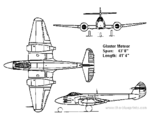swampyankee
Chief Master Sergeant
- 4,164
- Jun 25, 2013
I think that for whatever the reason, high build quality for the Me262 was going to be the exception rather than the rule. As Koopernic says:
"...The other is airframe tolerances. If one wing is slightly different to the other it will reach critical Mach ahead of the other and cause stability issues. Precision and high tolerances is essential in jets as are airfoils that have a high critical mach."
Germany's use of maltreated, underfed slave labor did little to improve build quality, but treating the peoples of invaded countries well was contrary to nazi ideology.

